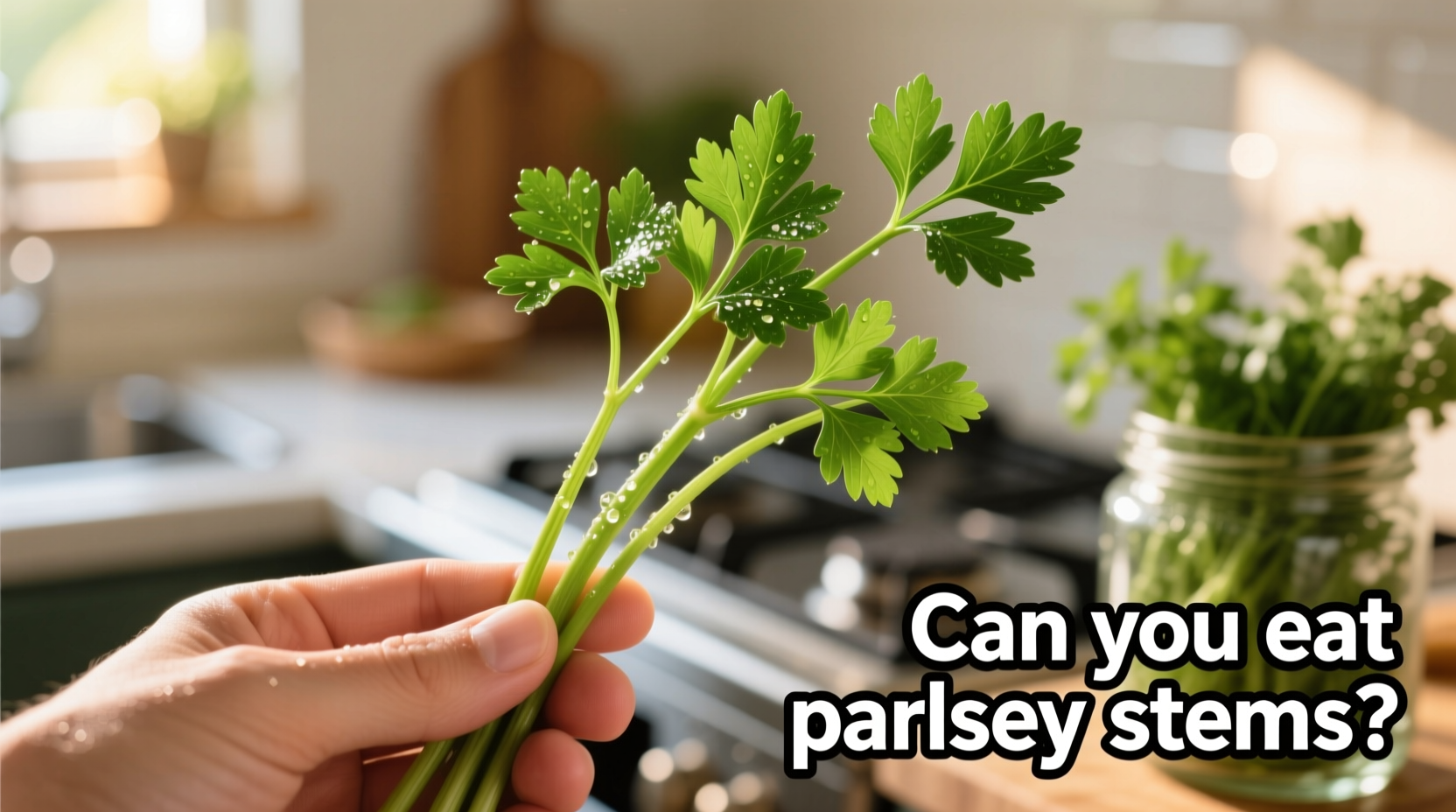Many home cooks instinctively discard parsley stems, unaware they're throwing away a culinary treasure. As a professional chef who's worked with herbs daily for over 15 years, I've seen this waste happen countless times. Let's correct this misconception once and for all and transform how you use one of cooking's most versatile herbs.
Why You've Been Misled About Parsley Stems
Contrary to popular belief, parsley stems aren't just edible—they're nutritionally superior to the leaves in several key areas. The confusion stems from texture differences rather than safety concerns. While the thicker base stems can be fibrous, the tender upper portions contain concentrated flavor compounds that professional chefs actively seek.
| Nutrient | Stems (per 10g) | Leaves (per 10g) |
|---|---|---|
| Vitamin K | 85mcg | 60mcg |
| Vitamin C | 12mg | 8mg |
| Flavonoids | 18mg | 12mg |
| Fiber | 0.7g | 0.4g |
Nutritional comparison based on USDA FoodData Central analysis of flat-leaf parsley (2024)
When Parsley Stems Shine: Practical Applications
The culinary world has quietly embraced parsley stems for decades. In professional kitchens, we use them strategically based on their unique properties:
- Flavor foundations: Finely minced stems added early in cooking (like in mirepoix) create deeper flavor bases than leaves alone
- Stock enhancement: Stems contribute more robust herbal notes to stocks and broths without becoming bitter
- Texture management: Tender upper stems work beautifully in salads and garnishes when properly prepared
- Nutrient preservation: Cooking with stems retains more water-soluble vitamins that would leach out if stems were discarded

Mastering Parsley Stem Preparation
Success with parsley stems depends entirely on proper handling techniques. Follow this professional workflow:
- Separate by tenderness: Divide stems into thick base portions (best for stocks) and tender upper sections (ideal for direct consumption)
- Cold water shock: Soak in ice water for 10 minutes to crisp fibers before chopping
- Strategic chopping: Use a rocking knife motion with firm pressure to break down fibrous strands
- Timing matters: Add tougher stems early in cooking; delicate upper stems in final minutes
Context Boundaries: When to Avoid Parsley Stems
While generally safe, there are specific situations where caution is warranted:
- Extremely woody stems: Base portions thicker than 1/8 inch may be too fibrous for direct consumption (better for stocks)
- Wild parsley confusion: Never consume wild-growing parsley relatives like fool's parsley (Aethusa cynapium) which are toxic
- Special dietary needs: Those on blood thinners should monitor total parsley consumption (stems contain higher vitamin K)
- Compromised freshness: Discard any stems showing brown spots or slimy texture
Historical Culinary Timeline
Professional chefs' approach to parsley stems has evolved significantly:
- 1950s-1980s: Stems routinely discarded as 'inedible' in most kitchens
- 1990s: Emergence of 'nose-to-tail' cooking philosophy extends to herbs
- 2005: Thomas Keller's French Laundry Cookbook features parsley stem pesto
- 2015-present: Food waste reduction movement makes stem usage standard practice
Maximizing Your Parsley Investment
Here's how to get complete value from your parsley bundle:
- Store whole bunch upright in water (like flowers) with a loose bag covering
- Use tougher stems within 24 hours for stocks; save tender portions for later
- Create 'parsley stem confit' by gently cooking in olive oil for versatile flavor base
- Freeze stems in oil cubes for instant flavor boosts in future dishes
Common Misconceptions Debunked
Let's address persistent myths about parsley stems:
- Myth: Stems contain harmful compounds
Truth: No scientific evidence of toxins in cultivated parsley stems (FDA GRAS status) - Myth: Stems taste bitter
Truth: Properly prepared stems have brighter, more complex flavor than leaves - Myth: Only flat-leaf parsley stems are usable
Truth: Curly parsley stems work well in stocks and cooked applications
Putting Knowledge Into Practice
Tomorrow's shopping trip presents your first opportunity to apply this knowledge. Select parsley with crisp, vibrant stems—this indicates peak freshness and tenderness. When preparing dinner, challenge yourself to incorporate stems into at least one dish using the techniques described. You'll likely discover enhanced flavor depth and reduce food waste simultaneously.
Frequently Asked Questions
Can you eat curly parsley stems?
Yes, curly parsley stems are completely edible. While slightly more fibrous than flat-leaf varieties, they work exceptionally well in stocks, soups, and stews where long cooking softens their texture. For direct consumption, focus on the tender upper portions and mince finely.
How do you chop parsley stems properly?
For optimal results, separate stems by thickness first. Use a sharp chef's knife and rock motion with firm pressure to break down fibers. Soaking in ice water for 10 minutes before chopping improves texture. For salads and garnishes, mince stems to 1/8 inch pieces; for cooked dishes, 1/4 inch is sufficient.
Are parsley stems more nutritious than leaves?
Yes, parsley stems contain higher concentrations of several nutrients including vitamin K, vitamin C, and flavonoids according to USDA FoodData Central. The stems' structural role in the plant concentrates these compounds, making them nutritionally valuable components of your diet when properly prepared.
Can parsley stems cause digestive issues?
When properly prepared, parsley stems shouldn't cause digestive issues for most people. Those with sensitive digestive systems may want to start with small amounts of tender upper stems. Avoid the thickest base portions if you have digestive concerns, as these contain more insoluble fiber that could cause discomfort in sensitive individuals.
How long do parsley stems stay fresh?
Parsley stems maintain freshness for 5-7 days when stored properly upright in water with a loose plastic bag covering in the refrigerator. Change the water every 2 days. For extended storage, freeze stems in olive oil cubes which preserves flavor for up to 6 months. Discard any stems showing brown spots or slimy texture immediately.











 浙公网安备
33010002000092号
浙公网安备
33010002000092号 浙B2-20120091-4
浙B2-20120091-4